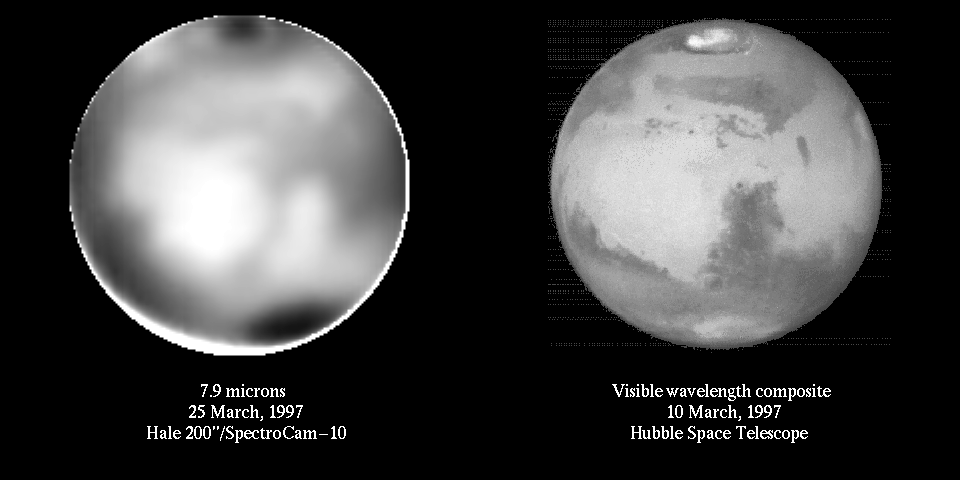

This image is one of several hundred thermal infrared
images and spectra of Mars collected at the 1997 opposition by J. Moersch,
T. Hayward, P. Nicholson, S. Squyres, J. Van Cleve, and J. Bell, of Cornell
University. The data were collected using the Cornell-built SpectroCam-10
instrument on the Hale 200" Telescope at Palomar Observatory. Below
are a description of this program and some notes on this specific image.
Jeff Moersch
moersch@astrosun.tn.cornell.edu
Overview of the Cornell Mars Thermal Infrared Survey
----------------------------------------------------
With SpectroCam we are able to take images (through six 1-micron-wide filters)
and spectra (at a spectral resolving power of 100) of Mars in the 8-14 micron
telluric window. The main goals of our work are to:
The first goal is essentially a "sneak peek'' at the sort of data we hope the Mars Global Surveyor Thermal Emission Spectrometer (TES) will return, albeit at much lower spatial resolution than TES will have. The second goal is something the TES will not be able to do well because determination of thermophysical properties requires observations of each part of the planet over a range of local times, and TES will orbit Mars in a sun-synchronous orbit. The third goal is important not only for its own intrinsic science value, but also in that it may provide information about martian atmospheric dust content that will be helpful for mission planning in the Mars Pathfinder and Mars Global Surveyor missions.
For more information, see "Identification
of a 10-micron silicate absorption feature in the Acidalia Region of Mars"
by Moersch, et al., in the March, 1997, issue of Icarus.
Notes on the image
------------------
This slide shows the Syrtis Major hemisphere of Mars at 7.9 microns from
SpectroCam on the left, and a visible-wavelength image of the same hemisphere
taken by the Hubble Space Telescope on the right. Both images were obtained
in March, 1997. In the emitted light observed by SpectroCam, Syrtis Major
shows up as a bright region, due to its lower albedo and resulting higher
surface temperature. To the left of Syrtis is Arabia, an area that shows
up as bright in the morning hours because of its low thermal inertia, which
allows it to heat up faster. South of Syrtis is the Hellas Basin, which
appears very dark because of the high, cold clouds in that region. The ice
of the residual north polar cap also shows up as a dark feature, ringed
by the brighter north polar sand sea. The raw SpectroCam image was divided
by a featureless synthetic image generated by a thermal model to remove
the dominant limb darkening caused by the diurnal insolation cycle. The
bright rim around the limb of the planet is just an artifact of this ratioing.
At this time the SpectroCam image was obtained, Mars was approximately 14 arcseconds in diameter; the relatively good spatial resolution (for this wavelength region) of the image was only possible because of the ~.5 arcsecond diffraction limit of the 200-inch telescope and some particularly good seeing conditions at the time the image was taken.